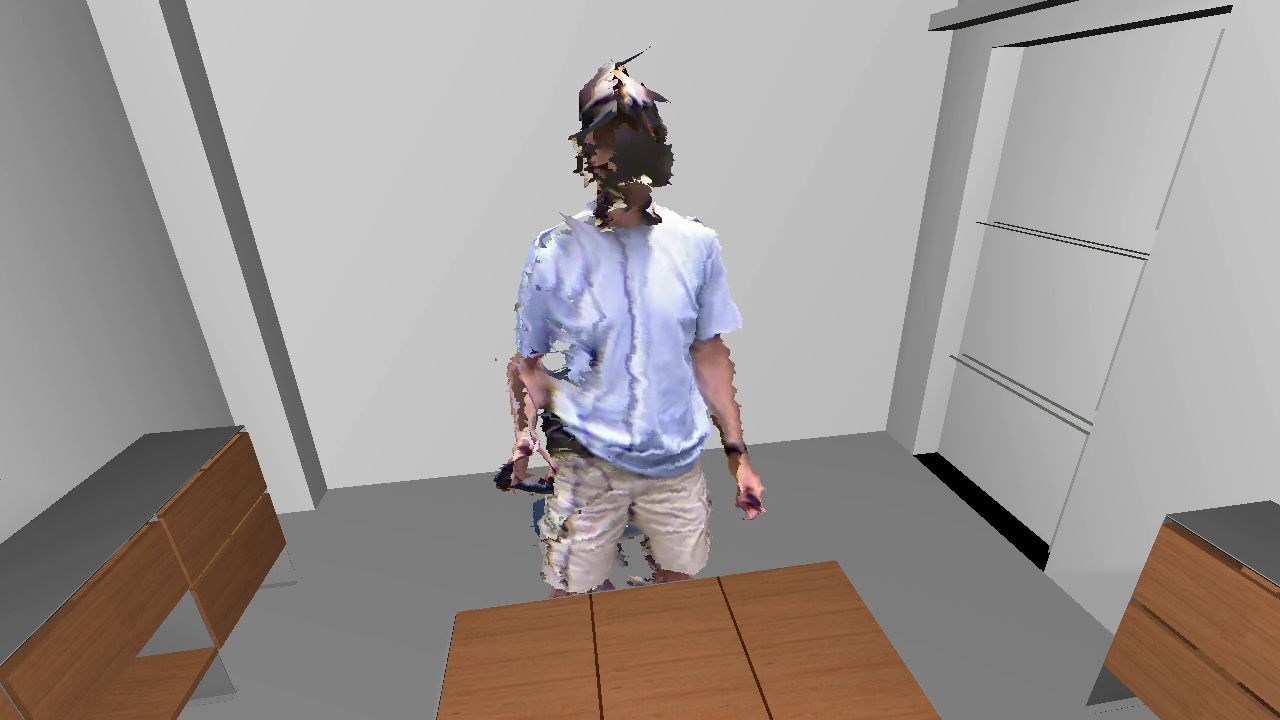Kinect Sensors Used to Enhance Oculus Rift Experience
Kinect and Oculus work together for an even more immersive experience.
When Kinect first came out, the gaming industry was overwhelmed by the weird and wonderful projects produced by the development community. Though Oculus Rift isn't yet widely available, Oculus VR has made units available to developers, and we're seeing a similar reaction as developers deliver new and interesting applications for this system. Today brings us another example of the awesome Oculus community, and this time they're throwing Kinect into the mix, too.
Oliver Kreylos has rigged up three Kinect sensors along with his Oculus Rift unit to create a 3D rendering of his body as he moves around in Riftland. The system powering this setup is a Linux machine powered by a Core i7 clocked to 3.5 GHz, 8 GB of RAM, and Nvidia's GeForce. It's connected to an external tracking server that monitors head position and wand position and orientation. The system receives raw depth and color image streams from three Kinects and drives an Oculus Rift and a secondary monoscopic view from the same viewpoint on the desktop display. As far as latency is concerned, Kreylos says that no one who has tried his system has noticed any disconnect due to latency issues. This is because his applications use raw depth and color video; latency is much lower than that of the skeletal reconstruction algorithm used by the Xbox. Even just watching the video, despite the low resolution and fuzzy nature of Kreylos' limbs, it's a trippy experience.
We've tried Oculus Rift a few times, and each time the only thing stopping us from completely losing ourselves in the virtual world created for us was the fact that when we looked down, it wasn't our own bodies that we were seeing. In fact, the first thing Chris, Marcus and I did when we tried Oculus Rift at CES was look down and try to move the virtual legs generated by the game. That one detail isn't enough to ruin the experience, but it's enough to tip your brain off that hey, this isn't real. When everything else is so immersive, that's a pretty big deal. With developers now working to overcome this detail, the future of Oculus Rift has never looked more exciting.
MORE: The Past, Present, And Future Of VR And AR: The Pioneers Speak
Follow Jane McEntegart @JaneMcEntegart. Follow us @tomshardware, on Facebook and on Google+.
Get Tom's Hardware's best news and in-depth reviews, straight to your inbox.

Jane McEntegart is a writer, editor, and marketing communications professional with 17 years of experience in the technology industry. She has written about a wide range of technology topics, including smartphones, tablets, and game consoles. Her articles have been published in Tom's Guide, Tom's Hardware, MobileSyrup, and Edge Up.
-
Ninjawithagun Kinect, Sminect...still don't see a consumer product ready for sale...over 2 years now and nothing...Reply -
icemunk ReplyKinect, Sminect...still don't see a consumer product ready for sale...over 2 years now and nothing...
Do you mean Oculus? The Kinect has been out for years... The Oculus hasn't released a retail version yet, but you can buy a developer kit (which still works the same) right off their website. -
Evolution2001 I think that's pretty awesome! It's neat to see more immersive VR taking place, especially being able to properly render yourself. I'm certain the author has already thought about an array of Kinects to give even more definition, similar to how we started with single channel/mono audio, then stereo, and then kept adding speakers (5, 7, 12) to make a more immersive experience.Reply
I think when we look back on the decade of 2010-2020, we're going to see a lot of great technology was released to the consumer & prosumer markets: SSDs, APUs/GPUs, Wireless & NFC, digital optics (DSLRs, Google Glass, camera phones, etc), 3D printers, uses for Graphene, and probably very near 'true' quantum computing before 2020. And in tech in general, the LHC & discovery of the Higgs-Boson, stem cell research advancements, gene therapy, advances in displays that use organic material (or going back to my graphene reference). These are exciting times to be interested in tech! -
starmajoris Very few things WOW me anymore on the tech industry and this is been going on for years. But I have to confess i was genuinely impressed and said 'wow' when i saw the arms reaching out. Tremendous potential for the future in gaming and VR.Reply
I feel real Sword Art Online on the making for 2025. :D -
alextheblue ReplyTremendous potential for the future in gaming and VR.
I would love to play a game like SAO. But until they can dump you into a true VR enviroment without your limbs thrashing around violently... not happening.
I feel real Sword Art Online on the making for 2025. :D
Anyway, he said he's using three first-gen Kinects. If he was using 3 or 4 of the latest Kinect 2.0 (or later) units with a more powerful system? Wow. Also wireless solutions instead of wires tethering him would be nice.
Anyway, I'd like to see Facebook and Microsoft work together to bring Oculus to XB1. That way I could use the same VR unit on XB1 and PC.

